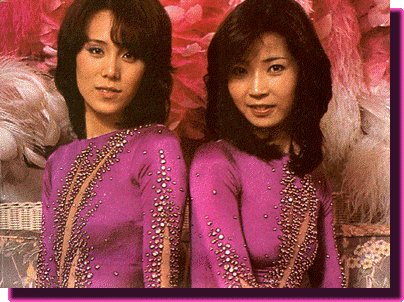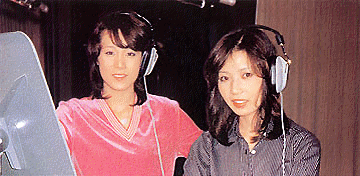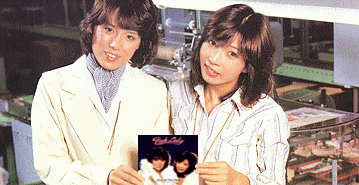KISS IN THE DARK
The John Vawter Review
"Kiss in the Dark" fits into the brief vogue of minor-key disco productions in late-1978 and 1979, of which "I Was Made for Dancin'" (another Michael Lloyd production) and Anita Ward's "Ring My Bell" are perhaps the most famous examples.
By 1979, disco had reached an impressive and expensive level of mechanization, accomplished at this point by tape loops and splicing (drum machines were still extremely primitive). A quick look at this song in an audio editor shows that even the tom-tom fill that kicks off the song is a quick succession of splices. The kick drums, snares, tom-toms, hi-hats and claps in the rhythm section are quite mechanical, the product of hours of studio time with white grease pencil and razor blade cutting up tape, though it sounds like the tambourine (which is rather grating) and the muted cowbell were played live. The arrangement contains horn section stabs, a rather small string section (sounds like 10 players or less), rhythm and (briefly) lead electric guitars, bass guitar and electric piano (or maybe a Yamaha CS-80 synth, it's buried in the mix so it's hard to tell).


The song's strengths include a hooky chorus, some sweet and innocent vocals from Mie & Kei (and this is possibly their best English pronunciation on record), and a decent arrangement for the horns, strings and guitars that stays out of the way. Upon more critical listening, my first impression is that the bass is out of tune with itself, the popped notes being quite sharp. It's quite noticeable in the verse, and most especially on the 12" single version of the song. Popping the bass too hard can pull the notes out of tune, though most bass players know this and compensate by re-tuning or not playing so hard. The song's form is slightly unusual in that it has a pre-chorus, sometimes called a "climb" ("I see through you like a window..."), which is more typical of Barry Manilow balladry. But perhaps it's not too surprising given that the producer (Lloyd) and record label (Curb) were known for white bread 1970s-style schmaltz, like the Osmonds and Pat & Debby Boone.
The song kicks off with a chorus instrumental intro where strings and horns outline the melody, and then it cycles through two verse/pre-chorus/chorus loops, bogs down in a "breakdown" section, and then repeats the chorus in a fade out. (A "breakdown" was by this point a disco cliche, all of the instruments are dropped out except for one, usually the drums, and then they are gradually brought back in, either one at a time or a section at a time. Typically there are two or more breakdowns on 12" single versions, since they pad out the songs nicely and they are meant to be played in dance clubs.) The first half of the breakdown is dominated by a flanged lead guitar that plays lazily a bit out-of-time with the track, though Mie & Kei's sexy whisper of "kiss" on the first downbeat of every other bar redeems this section. The last half features the male background singers in a solo of sorts, where they sing in a style highly derivative of the Bee Gees's "You Should Be Dancing", their unpleasantly reedy voices mixed much too loud, their black gospel-like moaning wildly inappropriate for the subject matter of the song, and their notes just a bit off pitch, to put it charitably. Far and away they are the weakest element, and they're the reason why I only give this song a C+.

A few months later, a Japanese/English version of "Kiss" appeared on "We Are Sexy", with a new arrangement by Kazufumi Ohama, and a much improved mix. The bass was re-recorded, and the tambourine is mixed much lower. Mie & Kei take over all the vocal duties, including Mie wailing in the fade out. The lead guitar plays tighter in the breakdown, and has a more active role, trading licks in the intro and the fade out also. The electric piano is gone, which gives the mix a more open sound since it doubled many of the same notes as the rhythm guitar in the original. The chorus is in English and the rest of the lyrics are in Japanese. The drum tracks remain fundamentally the same, though there are some pushed beats in the last bar of the verse, in the pre-chorus and the chorus, and they lend some pleasing rhythmic variety. The most striking feature is the string part, mixed up front and with a pretty plate reverb that recalls some of Mie & Kei's earlier hits like "Monster". This one's much better. I give it a B+.
A more radical departure was in store for the 1990 remix "Kiss in the Dark (House Odyssey Mix)". The arrangement is a NYC house mix, similar to Deee-lite's "Power of Love" from the same year. Elements include synth bass (an octave lower than the original), Roland TR-808 and various other drum machines, synth piano and synth brass ensembles, a sampled guitar riff similar to the Doobie Bros. "Long Train Runnin'", and some amusing vocal samples ("hey you, on your feet!" and "three, two, one, uh!"). The entire arrangement was no doubt played by one person with a sequencer and a sampler very cheaply. Mie & Kei's vocals were flown in from the original, but with Kei mixed a little louder, so the English sounds a tiny bit more fractured. The feel is more laid back, even though it's the same tempo and key, because the bass is much more sparse (the original bass pumped eighth notes almost continuously). At nearly six minutes it doubles the running time, mostly by repeating the breakdown and the second verse. While this sound and style has dated badly, this is a solid production that improves on the original. B+.
John Vawter, 36 as of this writing, is a music engineer who's worked in all genres of music from heavy metal to country. He currently lives in Los Angeles with his lovely wife Xiao Ling.
